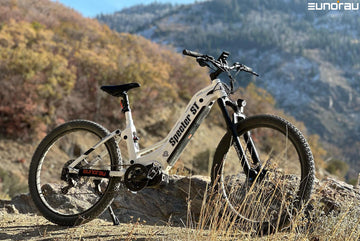
Can eBikes Handle Mountain Trails? What You Need to Know
Introduction
Electric bikes, or eBikes, have revolutionized personal transportation, commuting, and fitness riding. But many riders ask a more rugged question: "Can eBikes handle mountain trails?" With rocky terrains, steep climbs, unpredictable switchbacks, and a need for endurance, mountain trails are a real test for any bicycle. The answer isn’t just a simple yes or no—it depends on the type of eBike, how it’s equipped, and your riding knowledge. This article dives into everything you need to know to decide if your eBike is up for the challenge.
What Counts as a Mountain Trail?
Mountain trails vary widely depending on location, elevation, and climate. But they typically share several key features:
-
Uneven terrain: rocks, tree roots, and gravel
-
Elevation changes: steep ascents and descents
-
Technical features: switchbacks, jumps, and narrow paths
-
Variable surfaces: mud, sand, snow, or loose dirt
These characteristics make mountain trails more demanding than urban roads or paved bike paths. It requires a bike with the strength and capability to endure the elements and handle sudden shifts in momentum and terrain.
Best Types of eBikes for Mountain Trails
Not all eBikes are created equal. The ideal eBike for mountain trails is often referred to as an eMTB (electric mountain bike). These bikes are purpose-built with robust frames, high-torque motors, and long-travel suspension systems.
Here are a few eBike types suitable for trail riding:
1. Full-Suspension eBikes
These feature both front and rear suspension, providing maximum shock absorption. Great for rocky descents and rough terrain.
Recommended models:
-
Eunorau SPECTER-S
2. Hardtail eBikes
Equipped with only front suspension. Ideal for light trails and riders seeking a more budget-friendly option.

3. Fat Tire eBikes
With tires 4" or wider, these bikes offer excellent grip and stability, especially on loose or snowy surfaces. Perfect for soft trails and sand.
Fat tire advantages:
-
More surface contact for traction
-
Better performance in mud and snow
-
Absorbs shocks naturally
Motor Power and Battery Range
When it comes to mountain trail riding, power matters.
Motor Power
The steep inclines of mountain trails demand strong motors. Look for:
-
750W to 1000W motors: Offers enough torque for uphill riding
-
Mid-drive motors: Positioned at the crank, these offer better balance and efficiency
-
High torque ratings: Torque (Nm) is what helps you climb, not just motor watts
Battery Capacity
Range can vary widely depending on terrain and usage. Mountain riding typically consumes more power.
-
Minimum recommended battery: 48V 15Ah
-
Ideal range: 30 to 60+ miles
-
Consider dual battery systems for extended adventures (like the FLASH from Eunorau)
Tips for Riding eBikes on Mountain Trails
1. Lower Tire Pressure
Slightly reducing tire pressure increases traction. Fat tires work great when run at 8-15 PSI depending on weight and terrain.
2. Use Proper Gear Ratios
Learn to shift your gears proactively. Combine pedal assist with proper gearing for a smoother climb.
3. Maintain Your Brakes
Trail rides put heavy demand on your brakes. Hydraulic disc brakes are preferred for consistent stopping power.
4. Watch the Weight
eBikes are heavier than regular bikes. Be cautious on technical trails where quick handling is required.
5. Bring Backup Power
Always monitor your battery level. For longer rides, carry a charger or second battery.
6. Practice Before You Climb
If you’re new to mountain riding, practice on easier trails to get used to your eBike’s weight and responsiveness.
Are eBikes Legal on All Trails?
Trail access laws can be complex and vary by location.
eBike Classifications:
-
Class 1: Pedal assist only, up to 20 mph. Allowed on most trails.
-
Class 2: Throttle assist, up to 20 mph. Sometimes restricted.
-
Class 3: Pedal assist up to 28 mph. Rarely allowed on natural trails.
Check Local Regulations
Before hitting any trail, check with local park services or the Bureau of Land Management. Some U.S. states (like Colorado and Utah) are more eMTB-friendly than others.
Maintenance Tips for Trail Riders
Mountain terrain can be harsh on components. Routine checks can keep your ride smooth:
-
Clean your drivetrain after every trail ride
-
Inspect tires for cuts or debris
-
Check battery terminals for dust and moisture
-
Tighten bolts, especially on suspension and handlebars
-
Upgrade pedals and grips for better control
Can eBikes Handle Mountain Trails?
Absolutely—but with the right setup and preparation. If you choose an electric mountain bike designed for trail use, maintain it well, and ride with awareness, your eBike can not only handle mountain trails but also elevate your off-road experience.
Mountain trail eBiking combines the thrill of adventure with the power of modern technology. Whether you’re exploring backcountry paths, climbing steep ridges, or just enjoying nature with less strain, eBikes make mountain biking more accessible than ever before.
So next time someone asks, "Can eBikes handle mountain trails?" — you’ll know the answer is a confident and exhilarating YES.






















